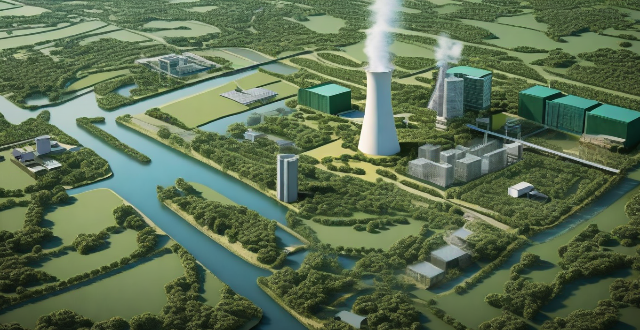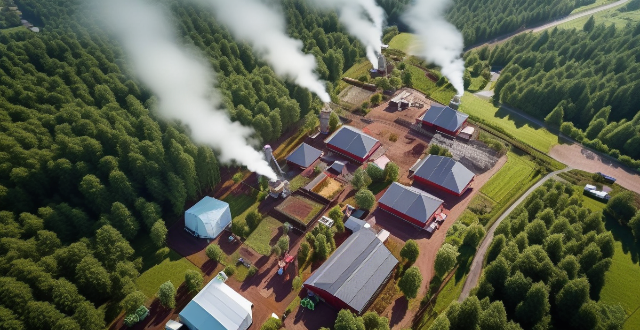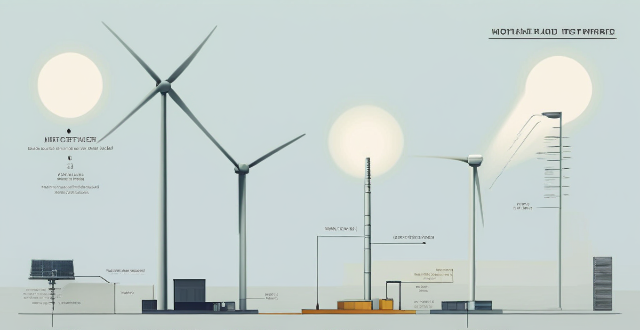Energy Water

How can the energy sector reduce its water footprint through innovations in technology ?
The energy sector's substantial water consumption is a concern for sustainable development. Technological innovations, such as efficient cooling systems, advanced water treatment, renewable energy integration, smart water management, waste heat recovery, and improved desalination methods, can help reduce the sector's water footprint. These innovations offer benefits like resource conservation, cost efficiency, and reduced environmental impact, ultimately contributing to global water security.

Are there any energy-saving tips for households ?
Energy conservation is essential for reducing environmental impact and utility bills. Here are some energy-saving tips for households: using energy-efficient light bulbs, maximizing natural light, setting thermostats to comfortable temperatures, using ceiling fans instead of air conditioning, sealing windows and doors, insulating the home, unplugging electronics when not in use, washing clothes in cold water, choosing energy-efficient appliances, lowering water heater temperature settings, insulating water heaters and pipes, fixing leaky faucets and showerheads, turning off electronic devices when not in use, using power management features on computers, and avoiding leaving devices on standby mode overnight. By implementing these tips, households can reduce their energy consumption and save money while contributing to a healthier environment.

Can hydroelectric power be considered a renewable energy source ?
Hydroelectric power is often considered renewable due to its reliance on the water cycle, but debates exist over its classification. Advantages include being a renewable resource, having low emissions, and providing energy storage. Disadvantages involve ecosystem impacts, community displacement, and siltation/erosion issues. The definition of "renewable" influences whether hydroelectric power is seen as truly renewable, with varying priorities leading to differing conclusions.

What are the most common types of renewable energy sources ?
Renewable energy sources are naturally replenished and provide a sustainable way to generate power without depleting the Earth's natural resources or contributing to climate change. Solar energy is harnessed through photovoltaic systems, solar water heaters, and concentrating solar power. Wind energy is captured by onshore and offshore wind turbines. Hydropower is generated through dam-based and run-of-river systems. Geothermal energy is tapped into via dry steam, flash steam, and binary cycle power plants. Bioenergy includes biomass combustion, anaerobic digestion, and biofuels. These sources offer clean alternatives to fossil fuels and play a crucial role in reducing greenhouse gas emissions.

Can you discuss the environmental impact of various energy storage methods ?
The text discusses the environmental impact of various energy storage methods, including batteries, pumped hydro storage, compressed air energy storage (CAES), and flywheels. It points out that while these methods allow for the efficient use of renewable energy sources and help to balance supply and demand, they also have varying levels of environmental impact. For example, battery production can result in water pollution and deforestation due to raw material extraction, while pumped hydro storage can affect local ecosystems and communities through land use and water usage. CAES may face challenges such as geological requirements and efficiency issues, and flywheels are considered an environmentally friendly option with a low environmental footprint. The text concludes that it is essential to consider both the efficiency and environmental implications of different energy storage solutions to ensure a sustainable future for our planet.

What are the most effective ways to reduce energy consumption in households ?
Reducing energy consumption in households is crucial for both environmental sustainability and cost savings. Here are some of the most effective ways to achieve this goal: 1. **Upgrade to Energy-Efficient Appliances** * Switch to appliances with an Energy Star rating, which use less energy while providing the same level of performance. * Consider investing in a smart thermostat that can automatically adjust the temperature based on your schedule and preferences. 2. **Improve Insulation and Air Sealing** * Ensure your home is well-insulated to minimize heat loss in winter and heat gain in summer. * Seal any air leaks around windows, doors, and other gaps to prevent drafts and improve energy efficiency. 3. **Optimize Lighting** * Replace traditional incandescent bulbs with LED or CFL bulbs, which use significantly less energy and have longer lifespans. * Install motion sensors or timers to automatically turn off lights when not needed. 4. **Use Energy-Efficient Water Heaters** * Consider upgrading to a tankless water heater, which only heats water as it's needed rather than storing it in a tank. * Insulate your existing water heater and pipes to reduce heat loss. 5. **Reduce Standby Power Consumption** * Unplug electronics when not in use or use a power strip with an on/off switch to easily cut off standby power. * Look for devices with low standby power consumption or opt for smart power management features. 6. **Implement Solar Power** * Install solar panels to generate renewable energy for your home, reducing reliance on grid electricity. * Use solar-powered outdoor lighting and other small appliances wherever possible. 7. **Be Mindful of Heating and Cooling** * Set your thermostat a few degrees lower in winter and higher in summer to save on heating and cooling costs. * Use ceiling fans or portable fans to circulate air and reduce the need for air conditioning. 8. **Maintain Your Home Efficiently** * Regularly clean and maintain your HVAC system, chimney, and other appliances to ensure they run efficiently. * Check for any potential issues like leaky faucets or running toilets that could waste water and energy. 9. **Cook Efficiently** * Use pressure cookers or microwaves for cooking, which can be more energy-efficient than traditional ovens. * Keep your refrigerator and freezer organized and avoid overloading them, allowing air to circulate more freely.

How can I reduce my electricity and water bills ?
To reduce electricity and water bills, one should switchTo reduce electricity and water bills, one should switch, adjust habits like turning off install water-saving fixtures, change bathroom habits, optimize garden watering, and be efficient with laundry and dishes.

What are some tips for reducing water consumption at home ?
Reducing water consumption at home can be achieved through various methods, including fixing leaks, installing water-saving fixtures, using efficient appliances, changing habits, being smart with gardening, and monitoring usage. By checking for drips, tightening fixtures, upgrading to low-flow toilets and showerheads, using Energy Star washers and dishwashers, turning off the tap while brushing teeth or shaving, watering the garden in the morning, and regularly reading the water meter, households can save money on utility bills and contribute to a more sustainable environment.

How does clean energy investment compare to traditional energy investment ?
Investing in energy sources is crucial for the development and growth of any economy. However, the choice between clean energy investment and traditional energy investment has become a significant topic of discussion in recent years. This comparison will explore the differences between these two types of investments, focusing on their costs, benefits, and potential impacts on the environment and society.

How does water conservation relate to overall energy efficiency and emission reduction ?
Water conservation is crucial for energy efficiency and emission reduction. It reduces the need for energy-intensive water treatment, distribution, and usage in various sectors like agriculture, industry, and households. Conserving water also maintains renewable energy sources like hydropower and reduces the environmental footprint of energy production. Therefore, water conservation contributes to a more sustainable future with efficient energy use and protection from climate change effects.

How does deforestation contribute to water cycle disruption ?
Deforestation contributes to water cycle disruption through soil erosion, surface runoff, and groundwater depletion. This leads to droughts, flooding, pollution, water scarcity, and climate change. Sustainable forest management is crucial to mitigate these effects.

How do I implement water conservation measures at home ?
Water conservation is crucial for sustaining the environment and ensuring future generations have access to clean water. Here's how you can implement water conservation measures in your home: identify areas of water consumption, repair leaks promptly, collect rainwater, educate family members, and regularly review your habits. By implementing these measures, you can significantly reduce your home's water usage and contribute to a more sustainable future for our planet.

What are the most effective ways to improve energy efficiency in buildings ?
Improving energy efficiency in buildings is essential for environmental and financial reasons. Effective methods include proper insulation, efficient lighting solutions, using energy-efficient appliances, smart controls, harnessing renewable energy sources, and conserving water. These strategies not only reduce operational costs but also create healthier spaces while contributing to sustainability.

What are the main sources of sustainable energy ?
The text discusses the various main sources of sustainable energy, including solar energy, wind energy, hydropower, geothermal energy, bioenergy, tidal and wave energy, and hydrogen energy. It also highlights the importance of adopting sustainable energy for environmental impact, economic benefits, energy security, and health considerations. The transition to sustainable energy requires investment, policy support, and technological innovation.

How does ecological design impact energy efficiency in buildings ?
Ecological design significantly impacts energy efficiency in buildings through various strategies like passive solar design, advanced insulation, renewable energy sources, energy-efficient appliances, water conservation, and sustainable material choices. These practices reduce energy consumption, lower operational costs, and minimize environmental harm.

How can existing buildings be retrofitted for energy efficiency ?
Retrofitting existing buildings for energy efficiency involves several strategies, including conducting an energy audit, upgrading insulation, installing energy-efficient windows and lighting systems, optimizing HVAC systems, using energy-efficient appliances, implementing water-saving measures, sealing air leaks, investing in renewable energy sources, and encouraging energy-conscious behavior. These steps can lead to cost savings, increased comfort, and reduced environmental impact.

How effective are large-scale water transfer projects in alleviating water scarcity ?
Water scarcity is a global issue, and large-scale water transfer projects aim to alleviate it by transporting water from areas with abundant resources to those with scarce ones. These projects can increase water availability, diversify water sources, and provide environmental benefits such as restoring depleted aquifers and wetlands. However, they also face challenges like high costs, negative environmental impacts, and social and political issues. To maximize the benefits of these projects while minimizing their drawbacks, careful consideration of their potential consequences and involvement of all relevant stakeholders in the decision-making process are essential.

How can we improve water resource management in our community ?
The article discusses the importance of water resource management in our community and suggests various strategies to improve it. These include raising awareness through educational campaigns, implementing water-saving measures like fixing leaks and using low-flow fixtures, upgrading infrastructure such as wastewater treatment plants, promoting sustainable practices like xeriscaping and green roofs, and fostering collaborative efforts among different stakeholders. By adopting these approaches, we can ensure the long-term availability of clean water while protecting the environment.

How does clean energy investment impact the environment ?
Clean energy investment positively affects the environment in various ways, including reducing greenhouse gas emissions, conserving natural resources, improving air quality, promoting sustainable practices, and enhancing long-term energy security. These efforts help mitigate climate change, protect ecosystems, reduce pollutants, encourage innovation and job creation, and stabilize energy prices. As environmental challenges persist, prioritizing clean energy investment is crucial for the planet's health and future generations.

How does climate change affect water resources and availability ?
Climate change affects water resources and availability through melting glaciers, changes in precipitation patterns, sea level rise, increased evaporation rates, and impacts on ecosystems. These impacts can lead to water scarcity, flooding, contamination of freshwater sources, and declines in biodiversity. To mitigate these effects, it is important to reduce greenhouse gas emissions and implement adaptation strategies such as improved water management and conservation measures.

How does geothermal energy work and is it a viable alternative energy source ?
Geothermal energy is a renewable and sustainable source of energy that harnesses the natural heat from within the Earth's crust. This energy is obtained by drilling wells into the Earth's crust, where the heat is transferred to water or another fluid in a heat exchanger. The heated fluid then spins a turbine to generate electricity. There are three main types of geothermal power plants: dry steam, flash steam, and binary cycle. While geothermal energy has many benefits, including being renewable, cost-effective, and abundant in certain areas, it also comes with high upfront costs and location limitations. Additionally, there are environmental impacts associated with its use, such as potential contributions to earthquakes and impacts on local ecosystems. Despite these challenges, geothermal energy remains a valuable addition to our portfolio of renewable energy sources.

What role do renewable energies play in enhancing energy security and mitigating climate change ?
Renewable energies enhance energy security and mitigate climate change by diversifying energy sources, providing sustainable and reliable energy supplies, enabling decentralized energy production, reducing greenhouse gas emissions, promoting clean air and water, and conserving natural resources.

What are some innovative ways to generate sustainable energy ?
The article discusses various innovative ways to generate sustainable energy. These methods include solar power, wind power, hydropower, geothermal energy, biomass energy, and wave energy, each with their unique techniques and systems.

What are the best practices for storing food and water for emergencies ?
When it comes to emergency preparedness, having a reliable supply of food and water is essential. Here are some best practices to ensure that you have what you need in case of an emergency: Food Storage: - Rotate regularly - Choose wisely - Portion control - Stay organized - Store safely Water Storage: - Quantity matters - Container choice - Replace regularly - Sanitize containers - Maintain accessibility Additional Tips: - Have a plan - Prepare for special needs - Be ready to cook

What is the role of renewable energy sources in energy-efficient buildings ?
Renewable energy sources play a crucial role in the construction and operation of energy-efficient buildings, providing clean, sustainable power that reduces reliance on fossil fuels and helps mitigate climate change. Solar energy is one of the most popular renewable energy sources used in energy-efficient buildings, harnessing the power of the sun to generate electricity or heat water for use in buildings. Wind energy converts the kinetic energy of wind into electricity, which can then be used to power buildings. Geothermal energy involves harnessing the heat from the earth's core to provide heating and cooling for buildings. Biomass energy uses organic materials such as wood chips, crop waste, and animal manure to generate heat and electricity for buildings. Hydropower involves using the energy of moving water to generate electricity. Incorporating these technologies into building designs and operations can create more sustainable and environmentally friendly structures that benefit both people and the planet.